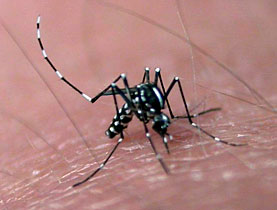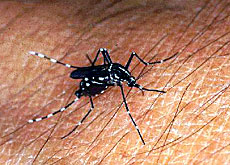Asian tiger mosquito crosses Alps

The Asian tiger mosquito, which can carry potentially fatal viral diseases, has been discovered in Switzerland north of the Alps for the first time.
Authorities said it was too soon to say whether they were dealing with an isolated mosquito that had been carried into the canton or one from a local population.
But the Federal Health Office added that there were no indications that the tiger mosquitoes found in canton Aargau were transmitters of infections such as dengue fever or chikungunya, a rheumatic viral fever.
“We don’t know how the mosquito came here. But now it’s winter and there won’t be a big problem,” Johannes Blum from the Swiss Tropical Centre in Basel told swissinfo.
In Switzerland tiger mosquitoes are active between March and October or November.
“We don’t know what will happen in summer, but [the working group in Ticino] is monitoring the situation and if there were an outbreak we could act very quickly.”
The Federal Health Office was also observing developments without being overly concerned. “Our reaction is to wait and see,” spokesman Jean-Louis Zürcher told swissinfo.
“The mosquitoes we found were not infected, but if we did find some infections in Switzerland we would certainly have to take measures. How we’d do that I don’t know.”
Limited risk
Asian tiger mosquitoes, so called because of white stripes on their legs and thorax, were first spotted in Italy in 1993, triggering alarm bells in the southern Swiss canton of Ticino.
In 2001 the Swiss authorities began implementing measures including a monitoring system in Ticino to prevent infiltration.
Nevertheless the first tiger mosquitoes appeared in Ticino in 2002.
Blum however played down the risks of an epidemic. “Tiger mosquitoes have been in Europe for quite a long time, especially in Italy, and for many years nothing has happened,” he said.
“Last year in Italy there was an outbreak of chikungunya fever with about 250 cases and one death. An outbreak like this could theoretically occur in Switzerland, but the risk of a chikungunya epidemic is small.”
The tiger mosquito, which originated in Southeast Asia, has a flight range of less than 200 metres and experts believe the worldwide transport of used tyres, probably from China, is to blame for its spread.
Blum adds that temperature differences could also play a role in mosquitoes’ changing breeding patterns. “In general we can say that global warming is a factor in mosquitoes being found in countries that were previously cooler.”
In addition, once it has established a foothold, the tiger mosquito has proved notoriously tricky to eradicate. Not only do females lay up to 150 eggs every few days, but they breed in anything that holds even the smallest amount of water.
No vaccine
Tiger mosquitoes are also very efficient transmitters of diseases, including Japanese encephalitis, dengue fever and chikungunya. While these diseases are not prevalent in Europe, there is a danger that the mosquito could bring them here.
The main symptoms – which usually appear between four to seven days after being bitten and can persist for several weeks – are high fever and joint pain, as well as headache, muscle pain, rash and less frequently gastrointestinal symptoms.
There is no vaccine against chikungunya or dengue fever and therefore the Federal Health Office has made it compulsory from January 2008 for all cases of chikungunya to be reported.
“With this we’ll have a certain idea if there is a problem or not. It’s not a very expensive measure but it’s quite an effective measure,” said Blum.
“The only problem is making sure that doctors are aware of the risk, can make the diagnosis and know when to do the special blood test for chikungunya.”
swissinfo, Thomas Stephens
The Asian tiger mosquito (aedes albopictus) is characterised by its black-and-white striped legs and small, black-and-white body.
It was originally native to Southeast Asia, but has been found in the southern United States since 1985. In 2007 the species was present in New Zealand, Eastern Canada and 12 European countries.
The typical tiger mosquito is about 2-10mm long. As with other mosquitoes, the female has an elongated proboscis that she uses to collect blood to feed her eggs. By contrast the male – which does not bite – feeds mostly on nectar.
The female tiger mosquito reproduces by laying her eggs near water, but not directly into it as other mosquitoes do, typically near a stagnant pool.

In compliance with the JTI standards
More: SWI swissinfo.ch certified by the Journalism Trust Initiative









You can find an overview of ongoing debates with our journalists here . Please join us!
If you want to start a conversation about a topic raised in this article or want to report factual errors, email us at english@swissinfo.ch.